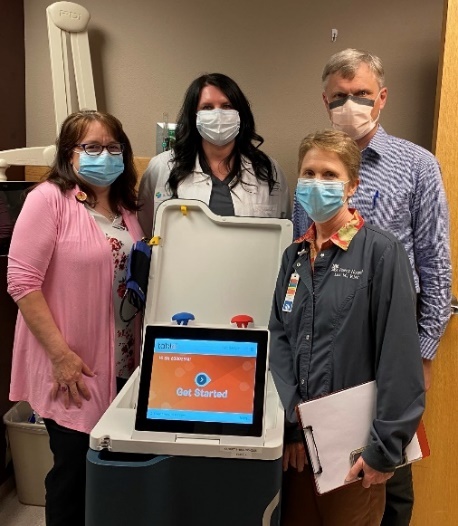The Only Hospital-Based Home Dialysis Program in Montana Delivers on Patient-First Promise

Summary
In rural communities like Helena, dialysis care for chronic kidney disease patients presents unique challenges. The St. Peter’s Health team is solving key issues with a patient-focused vision and device innovation.
With a rich history as a mining camp during the 1860s gold rush, Helena, Montana is still known for its pioneering spirit.
St. Peter’s Health holds the distinction as having the only hospital-based home dialysis program in the state, that has made bold changes to optimize care for one of its community’s toughest health challenges: kidney disease. Over the past year, the nonprofit health system has introduced novel, simplified dialysis technology to treat end-stage kidney disease (ESKD; also known as ESRD, or end-stage renal disease) patients in the five-county, 100-mile-radius surrounding area. In April 2021, it began converting its entire hemodialysis program to the first-of-its-kind Tablo® Hemodialysis System, starting in the home setting and followed by acute and in-center/outpatient care. As a result, more than 50% of its patients are now managing their dialysis at home compared to the national average of about 12.6%, and the system has increased staff efficiency, among other benefits.
The service line revamp was driven by factors that make the area and the hospital’s services unique—and especially challenging to ESKD patients. Helena is a rural community in the foothills of the Rocky Mountains, with patients often having to travel long distances to receive in-center dialysis treatment several days a week. These long or otherwise difficult commutes can include icy and snowy roads in the winter, and road closures due to more frequently occurring forest fires in the warmer months. Public transportation is not widely available, taxis or rideshare services are sparse, and many patients rely on family or friends to take them to in-center treatment.
A Patient-First Mindset

The St. Peter’s Health dialysis team is led by Medical Director Robert LaClair, MD, who has been very supportive of bringing on Tablo. With a “patient-first” vision for dialysis, his goal is to provide patients with a flawless care experience, treat them with respect, do what’s best for them individually and offer patients, in his words, the ability to be content.
“The previous technology we used for home hemodialysis was just too complex and time-consuming. There’s no comparison. For those who are converting from PD [peritoneal dialysis], we now have an easy option for them to switch to hemodialysis with Tablo, where before we would have them go in-center,” he says. “Those patients can stay at home with something that is easy to use and provides adequate clearance, so they’re not having to do six treatments a week. Tablo is like going from DOS to the Apple iOS operating system, where you don’t see a lot of the intricacies of the software, but the interface is simple.”
Dr. LaClair, Alice Luehr, DNP, RN, CNN, Director of Dialysis, and their care team are focused on educating ESKD patients about their treatment options, and providing them with a high quality of life. The team has many years of experience with different dialysis machines, and with the challenges of home dialysis in a rural community.
“Some home patients have used a different dialysis machine, that was complicated and overall a bigger burden for them,” says Luehr, who has spent the last 32 years at St. Peter’s Health, 22 in dialysis. “We would sometimes use our personal vehicles to help bring supplies to their homes. In the winter, there would even be problems with dialysate solution freezing in the delivery trucks.”
Luehr was introduced to Tablo at a symposium a few years ago, where she could see that the dialysis burden, including training and issues such as alarm resolution, would be reduced in comparison to their existing machines. Earlier last year, Luehr and Dr. LaClair received leadership approval to replace their machines with Tablo consoles. The team now manages about 21 patients on hemodialysis or PD at home, and about 30 in-center patients.
“Tablo has given us total control over the dialysis we can provide to our community, and can very easily fit into someone’s home.”
– Robert LaClair, MD
“Tablo has given us total control over the dialysis we can provide to our community, and can very easily fit into someone’s home. That kind of flexible decision-making is exactly what you want to be able to offer,” says Dr. LaClair. “I’m a proponent for Outset Medical because they are getting patients involved and giving them control over their care. They are making dialysis simple and not pretending it’s so complex that no one can figure out how to use it. These are the important things that matter if we’re going to break the barriers of the past in dialysis.”
Home on the Range
Since St. Peter’s Health began offering Tablo as the sole home hemodialysis option a year ago, the team has seen increased interest in home therapy.
“The simplicity of Tablo certainly has opened the door for more candidates to have success at home,” says home dialysis nurse Lisa Mott, RN, CNN, a nurse for 30 years and with St. Peter’s Health for the last 20 years. “Patients seem to be less intimidated, and that’s been really good.”
“Tablo is less cumbersome to move around. It looks like a little refrigerator. Our in-center and home patients are very impressed with it, and we’re getting tons of positive feedback,” adds Luehr.
“It’s nice for our in-center patients to know that the same machine that they’re receiving treatment on can go home with them.”
– Alice Luehr, DNP, RN, CNN
Luehr also says that having the same device available from hospital to home has been a big plus. “It’s nice for our in-center patients to know that the same machine that they’re receiving treatment on can go home with them,” she says. “The motto I always say about home dialysis patients is they don’t have to show us they can, they have to show us they can’t.”
“I’ve seen that anybody can do it who wants to do it,” adds Mott. “The intimidation level goes down significantly when they see the touchscreen animations and instructions. It’s very user-friendly, more so than other machines we’ve worked with. With Tablo, they can also do fewer treatments in less time. Freeing up their time is the number one benefit that patients mention.”
The device’s remote monitoring and intelligent system management capabilities also serve to support patients at home.
“I use Tablo remote monitoring a lot, especially with my patients who have blood pressure or catheter issues, and especially in the wintertime,” says Jamie Seymour, RN, a home dialysis nurse at St. Peter’s Health with 22 years of nursing experience. “It’s almost like being right there with the patient.”
Acute Care Conversion—and an Unexpected Relocation
After several months of success with sending patients home with Tablo last year, the team got the go-ahead to convert their in-house acute and chronic dialysis units to a fleet of Tablo consoles. Being a smaller hospital, the in-center dialysis staff also manages acute patients.
“Prior to Tablo, we had portable RO [reverse osmosis] units that we’d take over to ICU and then our great big dialysis machines, so we’d take up a lot of space in a room,” says Luehr. “Then in September, both of our RO units broke down. We were right in the middle of COVID and had people who needed dialysis. We had an expensive water treatment room also. Following our acute conversion in October and staff adjusting to the new technology, Tablo and the Outset team are helping us in so many ways.”
Recently, the team discovered how uniquely versatile the system can be. On a Friday afternoon in May, the hospital area where the dialysis unit is located developed a plumbing problem that would require extensive repairs. Due to the mobility and ease of use with Tablo, the team was able to quickly move its fleet of machines into a separate unit with unused patient rooms. In just a few hours, all the consoles were connected to tap water and electricity in the new location and ready for use early Saturday morning.
“That’s a miracle. We have patients that are happily sitting in chairs right now getting dialysis,” says Dr. LaClair. “This would not have happened with other devices. We would have been figuring out ways to transport them to other locations in the state. It would have been an absolute disaster and yet, we were able to easily and completely move an entire unit. Tablo gives us options. As a physician I love it, and am so proud of what we just did.”
About St. Peter’s Health
St. Peter’s Health is a system of health care services including a 99-bed acute care hospital, physician clinics, cancer treatment center, behavioral health unit, urgent care clinics, home health and hospice care, dialysis center and ambulance services. St. Peter’s Health serves the Helena region and southwest Montana counties of Lewis and Clark, Broadwater, Jefferson, Meagher and Powell, with a combined population of approximately 97,000 residents. The mission of St. Peter’s Health is to partner with patients and the community to provide exceptional and compassionate health care.
The views and opinions expressed herein represent the personal opinions of the facility staff, and do not represent the views or opinions of other persons, institutions or organizations.

